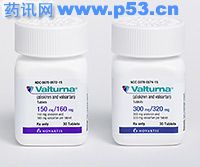制造商:
诺华制药公司
药理分类:
抗高血压(直接肾素抑制剂+血管紧张素Ⅱ受体阻滞剂)
活性成分(补):
阿利吉仑为150mg,缬沙坦160mg;标签。
另外:
VALTURNA 300mg/320mg
阿利吉仑300毫克,缬沙坦320mg;标签。
指示(补):
高血压,抗高血压药物单用或与其他。由于患者可能需要多种药物,以达到目标血压的初步治疗。
药理作用:
Valturna结合阿利吉仑,直接肾素抑制剂,缬沙坦,血管紧张素Ⅱ受体阻滞剂(ARB)。肾素的分泌在响应血量减少,肾血流灌注的肾脏,掀起了级联,导致钠潴留,醛固酮的分泌,血管收缩,血压升高的一个。阿利吉仑降低血浆肾素活性,抑制血管紧张素转化为血管紧张素,在血压下降造成的。缬沙坦也适用于通过肾素血管紧张素醛固酮系统。它会阻止的升压剂,血管紧张素Ⅱ,在血管平滑肌和肾上腺中对AT1受体结合。总之,这两种药物在降低血压的辅助行动。
临床试验:
8周,随机,双盲,安慰剂对照研究进行了1797例。这项研究是一个平行组,四臂,剂量递增试验中,阿利吉仑和缬沙坦在150毫克的剂量和160mg,分别展开,并在4周增加至300毫克和320mg,分别为。血压(坐,袖口槽)为计量基准,在4周,8周。鉴于联合治疗患者血液中有比那些给予两种药物单用压力明显下降较多。
Valturna也评价作为初始治疗。在所有基线血压水平,实现任何目标的概率收缩压或舒张压与Valturna比单独使用两种药物300/320mg更大。该Valturna达到降压效果在2个星期。
法律分类:
接收
成人:
对于一贯采取膳食(由高脂肪食物减少吸收)。 1片,每天一次。附加或初始治疗,而不是卷的枯竭:最初150/160mg; 2-4周后可能会增加至最大300/320mg。替代疗法:可替代的滴定组件。
儿童:
不推荐。
警告/注意事项:
正确的低血容量开始之前,或开始密切监督。瑞士法郎。最近的心肌梗塞。重症患者的肾功能于肾素血管紧张素醛固酮系统依赖心脏衰竭。严重肝或肾功能不全。肾动脉狭窄。肾病综合症。肾性高血压。历史透析。手术。监测电解质。妊娠(Cat.D);避免的。哺乳母亲:不推荐。
互动(补):
伴随环孢素:不推荐。高钾血症与K +的补充,钾利尿剂,钾补充剂含有盐。 Potentiated阿托伐他汀,酮康唑。五月对抗速尿。拮抗厄贝沙坦。
不良反应(补):
疲劳,鼻咽炎,肠胃不适,稀有:低血压,血管性水肿(停止如果发生)。
如何提供:
制表- 30,90
最后更新:
2010年1月7日
VALTURNA 150mg/160mg
Manufacturer:
Novartis Pharmaceuticals Corp
Pharmacological Class:
Antihypertensive (direct renin inhibitor + angiotensin II receptor blocker)
Active Ingredient(s):
Aliskiren 150mg, valsartan 160mg; tabs.
Also:
VALTURNA 300mg/320mg
Aliskiren 300mg, valsartan 320mg; tabs.
Indication(s):
Hypertension, as monotherapy or with other antihypertensives. As initial therapy in patients likely to need multiple drugs to achieve blood pressure goals.
Pharmacology:
Valturna combines aliskiren, a direct renin inhibitor, and valsartan, an angiotensin II receptor blocker (ARB). Renin is secreted by the kidneys in response to a decrease in blood volume and renal perfusion, setting off a cascade that causes sodium retention, aldosterone secretion, vasoconstriction, and an increase in blood pressure. Aliskiren reduces plasma renin activity and inhibits the conversion of angiotensinogen to angiotensin I, resulting in a decrease in blood pressure. Valsartan also works via the renin-angiotensin-aldosterone system. It blocks the binding of the pressor agent, angiotensin II, to the AT1 receptors in vascular smooth muscle and in the adrenal gland. Together, these two drugs have complementary actions in the reduction of blood pressure.
Clinical Trials:
An 8-week, randomized, double-blind, placebo-controlled study was conducted in 1797 patients. This study was a parallel-group, four-arm, dose escalation trial in which the doses of aliskiren and valsartan were started at 150mg and 160mg, respectively, and increased at 4 weeks to 300mg and 320mg, respectively. Blood pressure (seated, cuff trough) was measured at baseline, at 4 weeks, and at 8 weeks. Patients given the combination therapy had significantly greater reductions in blood pressure than those given monotherapy for either drug.
Valturna was also evaluated as initial therapy. At all levels of baseline blood pressure, the probability of achieving any given systolic or diastolic goal is greater with Valturna 300/320mg than for either drug used alone. The antihypertensive effect of Valturna was attained within 2 weeks.
Legal Classification:
Rx
Adults:
Take consistently with regard to meals (absorption reduced by high-fat meals). 1 tablet once daily. Add-on or initial therapy and not volume-depleted: initially 150/160mg; may increase after 2–4 weeks to max 300/320mg. Replacement therapy: may be substituted for the titrated components.
Children:
Not recommended.
Warnings/Precautions:
Correct hypovolemia before starting, or start under close supervision. CHF. Recent MI. Severe heart failure in patients whose renal function depends on renin-angiotensin-aldosterone system. Hepatic or severe renal dysfunction. Renal artery stenosis. Nephrotic syndrome. Renovascular hypertension. History of dialysis. Surgery. Monitor electrolytes. Pregnancy (Cat.D); avoid. Nursing mothers: not recommended.
Interaction(s):
Concomitant cyclosporine: not recommended. Hyperkalemia with K+ supplements, K+ sparing diuretics, K+ containing salt supplements. Potentiated by atorvastatin, ketoconazole. May antagonize furosemide. Antagonized by irbesartan.
Adverse Reaction(s):
Fatigue, nasopharyngitis, GI upset; rare: hypotension, angioedema (discontinue if occurs).
How Supplied:
Tabs—30, 90


